Table of Contents
1. SELF RELIANT INDIA (SRI) FUND
TAG: GS 3: ECONOMY
THE CONTEXT: As a part of the Aatmanirbhar Bharat package, the Rs 50,000 crore Self Reliant India (SRI) Fund has been set up to infuse Rs. 50,000 crore as equity funding in those MSMEs which have the potential and viability to grow and become large units.
EXPLANATION:
- Under this fund, there is a provision of Rs 10,000 Crore from the government and Rs 40,000 crore through private equity and venture capital funds.
- The fund operates through a mother-fund and daughter-fund structure for equity or quasi-equity investments.
- NSIC Venture Capital Fund Limited (NVCFL) operates as Mother Fund in SRI Fund.
- It is registered as a Category-II Alternative Investment Fund (AIF) with SEBI.
- The fund aims to enhance equity support to MSMEs and improve listing on stock exchanges as more enterprises get into the formal sector.
- The fund’s tenure is 15 years which may be extended as per AIF guidelines and subject to approvals from NVCFL and contributors.
How does the SRI fund work?
- Employing a fund-of-funds strategy, the SRI fund invests in SEBI-registered Category I and Category II AIFs called daughter funds, which in turn invest in MSMEs.
- The government is the sole anchor investor in the fund, with the initial support of Rs 10,006 crore as the mother fund.
- The corpus is expected to be enhanced to Rs 50,000 crore with Rs 40,000 crore from daughter funds during the 15-year tenure of the fund, while the investment or commitment period is 13 years.
How many daughter funds are empanelled?
- According to NSIC Venture Capital Fund (NVCFL), there are 44 daughter funds viz., TATA Capital Healthcare Fund, Aavishkaar India Fund, SVL-SME Fund, Gaja Capital India Fund, Avaana Sustainability Fund, ICICI Ventures’ India Advantage Fund S5 I and more.
- The investment manager of the fund is SBICAP Ventures – the private equity arm of State Bank of India (SBI).
- The target return for the daughter fund is a gross IRR (internal rate of return) of 12 per cent per annum. Gross IRR is referred to the return on investment without taking into account any management fees and costs.
- Management fees for daughter funds should not be more than 2 per cent per annum.
Are there preferred sectors for investment under SRI fund?
- According to NVCFL, SRI is a sector-agnostic fund to support MSMEs in agriculture, pharma, auto, chemicals, etc., undertaking manufacturing or services business except for investments in gambling, self-help groups, and any illegal or unlawful activities.
What type of MSMEs will be targeted for investments?
- As per the fund’s guidelines, MSMEs with a “defined business plan for growth indicating positive funds flow” will be targeted.
- Moreover, compound annual growth of the business for the previous three years will also be considered.
- The Fund will also factor in non-monetary aspects in terms of employment, reduction in regional disparity, overall economic development and establishment of supply chains with depth and resilience.
- The investment made and equity diluted is based on the assessment of the MSME borrower.
2. ULLAS: NAV BHARAT SAKSHARTA KARYAKRAM
TAG: GS 2: SOCIAL JUSTICE
THE CONTEXT: The Union Minister of Education and Minister of Skill Development and Entrepreneurship, at the Akhil Bharatiya Shiksha Samagam 2023 introduced the mobile application the ULLAS: Nav Bharat Saksharta Karyakram. The occasion coincided with the third anniversary of NEP 2020.
EXPLANATION:
- The ULLAS initiative aims to revolutionise education and literacy across the nation by fostering a comprehensive learning ecosystem that caters to every individual, bridging gaps in basic literacy and critical life skills.
- Its focus extends to promoting functional literacy, vocational skills and essential life skills such as financial literacy, legal literacy, digital literacy and empowerment of citizens to participate in nation-building.
- The newly-unveiled logo and slogan, “ULLAS: Nav Bharat Saksharta Karyakram”, symbolise the campaign’s enthusiasm and vigour in spreading knowledge and education to every corner of the country.
- The initiative aims to ignite the flame of curiosity and continuous learning in each individual, fostering a culture of knowledge-sharing in communities across India.
- It also fosters a culture of continuous learning and knowledge-sharing in communities across India.
Target Group of the initiative:
- The app serves as a digital gateway to engage learners with diverse educational resources through the DIKSHA portal of NCERT.
- Learners and volunteers can register through self-registration or via surveyors.
- The programme primarily targets citizens aged 15 and above who missed the opportunity to attend formal schooling.
- It operates through volunteerism, encouraging volunteers to participate as DUTY or Kartavya Bodh towards nation-building.
- Student volunteers will be incentivised with credits in school/university and appreciation through certificates, letters of appreciation, felicitation, among other means.
The National Policy on Education 2020:
- The NEP 2020 is the first education policy of the 21st century and replaces the thirty-four-year-old National Policy on Education (NPE), 1986.
- It is built on the foundational pillars of Access, Equity, Quality, Affordability and Accountability and is aligned to the 2030 Agenda for Sustainable Development.
- It aims to transform India into a vibrant knowledge society and global knowledge superpower by making both school and college education more holistic, flexible, multidisciplinary.
Outcomes of NEP 2020:
- Universalization from Early childhood care and education (ECCE) to Secondary Education by 2030, aligning with SDG 4
- Attaining Foundational Learning & Numeracy Skills through National Mission by 2025
- 100% GER in Pre-School to Secondary Level by 2030
- Bring Back 2 Cr Out of School Children
- Teachers to be prepared for assessment reforms by 2023
- Inclusive & Equitable Education System by 2030
- Board Exams to test core concepts and application of knowledge
- Every Child will come out of School adept in at least one Skill
- Common Standards of Learning in Public & Private Schools
3. GEOGRAPHICAL INDICATION (GI) TAG ACCORDED TO SEVEN PRODUCTS
TAG: GS 3: ECONOMY
THE CONTEXT: Seven products from across India, including four from Rajasthan, were given the Geographical Indication (GI) tag by the Geographical Indications Registry in Chennai.
EXPLANATION:
- Seven products from across India, including four from Rajasthan, were given the Geographical Indication (GI) tag by the Geographical Indications Registry in Chennai.
- The GI tags were secured by ‘Jalesar Dhatu Shilp’ (a metal craft), ‘Goa Mankurad Mango’, ‘Goan Bebinca’, ‘Udaipur Koftgari Metal Craft’, ‘Bikaner Kashidakari Craft’, ‘Jodhpur Bandhej Craft’, and ‘Bikaner Usta Kala Craft’.
- Goa Mankurad Mango: This variety of mango is also known as malcorada, cardozo mankurad, corado, and Goa mankur. The Portuguese named the fruit malcorada, which means ‘poor coloured’, and with time, it became mank urad aam (mango) in Konkani.
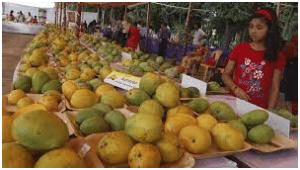
- Goan Bebinca: Bebinca, also known as the ‘queen of Goan desserts’, is a traditional Indo-Portuguese pudding.

- Jalesar Dhatu Shilp: This craft belongs to Jalesar in Uttar Pradesh’s Etah district. These include gurus (anklets), giants (bells) and other decorative metal craft and brassware. The Thatheras community, which resides in a mohalla (locality) named Hathuras, makes these products.
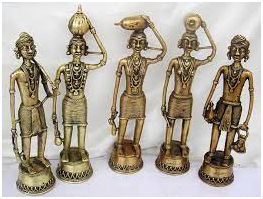
- Udaipur Koftgari Metal Craft: According to the documents submitted to the GI Registry, weapons are exquisitely ornamented by a complicated process of etching designs, heating, and then cooling, intertwined with embedding gold and silver wire and finally polishing it.
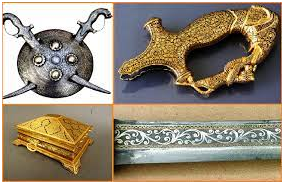
- Bikaner Kashidakari Craft: These are traditionally created on cotton, silk or velvet with a variety of fine stitches and mirror-work, mainly for objects associated with marriage, especially gift items. The mirrors are believed to repel the ‘evil eye’ with their reflective surfaces. The weaving of fabrics by hand used to be done by the Meghwal community in Bikaner and nearby districts.
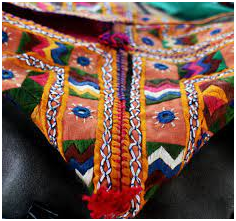
- Jodhpur Bandhej Craft: It is the Rajasthani art of tying and dyeing. Bandhej is one of the most famous textile art forms in Rajasthan. The fabrics used for Bandhej are muslin, silk and voile. Cotton thread is used for tying the fabric.
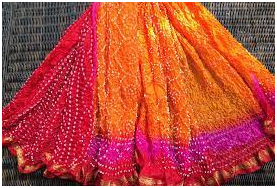
- Bikaner Usta Kala Craft: It is also known as gold Takashi or gold manual work due to the prominence of its long-lasting golden colour. Untreated raw camel hide is processed and moulded by the Dapgar community of leather craftspeople for the requirements of the Usta.
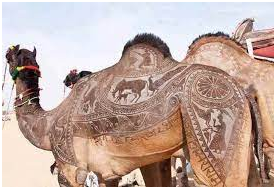
What is Geographical Indications Tag?
- A geographical indication (GI) tag is a sign used on products that have a specific geographical origin and possess qualities or a reputation that are due to that origin.
- The following types of goods are covered under the ambit of GI –
- Agricultural (example, Basmati rice)
- Natural (example, Makrana marble)
- Handicrafts or of any industry (for example, Kashmiri pashmina)
- Foodstuff (example, Dharwad pedha)
- The Geographical Indications of Goods (Registration and Protection) Act, 1999, along with the Geographical Indications of Goods (Registration and Protection) Rules, 2002 govern GI registrations and goods.
- It is in compliance with the Trade-Related Aspects of Intellectual Property Rights
(TRIPS ) The agreement of WTO prescribes minimum standards for the protection of GI that all WTO members must provide.
- According to Section 58(1) of the GI Act, in any case where the validity of the registration of a geographical indication is questioned, the case would be under the jurisdiction of the Intellectual Property Appellate Board.
- Geographical Indications Registry in Chennai has complete jurisdiction over the GI goods in India, including, but not limited to, their registration and application process.
Intellectual Property Appellate Board (IPAB):
- It is a quasi-judicial body that was constituted in September 1958 and entrusted with the task of adjudication of disputes pertaining to copyright registration, and assignment of copyright.
- The Intellectual Property Appellate Board (IPAB) has the appellate jurisdiction.
- It grants licenses in respect of works withheld from public, unpublished Indian works, production and publication of translations and works for certain specified purposes.
- It also hears cases in other miscellaneous matters instituted before it under the Copyright Act of 1957.
- The website of the IPAB boasts of being the only tribunal in India which has an international influence.

4. PAHARIS AND PADDARIS PROPOSED FOR THE SCHEDULED TRIBES STATUS IN JAMMU AND KASHMIR.
TAG: GS 1: SOCIETY; GS 2: POLITY
THE CONTEXT: Justice G D Sharma Commission was appointed by Govt. of Jammu and Kashmir in March 2020 to identify groups that were socially, educationally, and economically backward.
The Commission in its report recommended ST status for Gadda Brahmins, Kolis, Paddari Tribe, and Pahari Ethnic Group.
EXPLANATION:
- The government has brought a Bill to include four communities, Gadda Brahmin, Koli, Paddari Tribe, and Pahari Ethnic Group, in the list of Scheduled Tribes (STs) in Jammu and Kashmir.
- The Constitution (Jammu and Kashmir) Scheduled Tribes Order (Amendment) Bill, 2023 is one of the four Bills relating to the Union Territory that were introduced in Lok Sabha.
STATUS OF ST COMMUNITIES IN J&K
- The dominant ST communities in J&K are the Gujjars and Bakerwals.
- They live in the districts of Rajouri, Poonch, Reasi, Kishtwar, Anantnag, Bandipora, Ganderbal, and Kupwara.
- Bakerwals are nomadic and they migrate with their livestock to the higher reaches in the summer and return before the onset of winter.
- Gujjar-Bakerwals are the third largest group after Kashmiris and Dogras in J&K.
- They were given ST status in 1991, along with the two smaller groups of Gaddis and Sippis.
- This entitled these four communities to 10% reservation in government jobs and admission to educational institutions.
- In 2019, they were empowered politically after the Centre announced a 10% quota for them in Lok Sabha and Assembly seats in J&K.
- The proposed expansion of the ST list has triggered unrest among the Gujjar-Bakerwal, who apprehend a shrinking of their share of the quota benefits pie. The Bill says the amendment “may entail additional expenditure on account of benefits to be provided to persons belonging to the said [four] communities”.
- Gujjar-Bakerwal leaders are especially agitated with the proposed ST status for Paharis and Paddaris.
- Gadda Brahmins and Kolis are very small communities. Gadda Brahmins are a branch of the Gaddis while Kolis are a sub-caste of Sippis, and both these communities are already in the ST list.
PAHARI ETHNIC GROUP
- The Paharis are Hindus, Muslims, and Sikhs, and people of Kashmiri origin who settled in the districts of Rajouri and Poonch.
- In 1989, the J&K government recommended that Paharis should be included in the list of STs along with the Gujjars, Bakerwals, Gaddis, and Sippis.
- It was rejected on the ground that there was no caste/ tribe of that name in its records.
- An Advisory Board was setup for Development of Pahari Speaking People. The Board defined Paharis as all people living in Rajouri and Poonch except those who were STs.
- The Paharis finally got 4% reservation in jobs and educational institutions in 2019.
- Justice G D Sharma Commission was appointed which recommended ST status for Gadda Brahmins, Kolis, Paddari Tribe, and Pahari Ethnic Group.
- The report was sent to the Tribal Affairs Ministry, and the Registrar General approved it in 2022.
PADDARI TRIBE
- They live in the remote Paddar area of the hilly Kishtwar district, which is spread over two tehsils, the Paddari homeland borders Zanskar (Ladakh) in the north and the east, Pangi in Himachal Pradesh in the south, and the rest of J&K in the west.
- The 2011 census recorded the Paddari population at 21,548, comprising 83.6% Hindus, 9.5% Buddhists, and 6.8% Muslims.
- The people of the area, including those who have come from elsewhere to settle there, speak the Paddari language.
- Gujjar-Bakerwal opposition to the proposed inclusion of the Paddari Tribe in the ST list is based on the argument that they do not constitute a single ethic group but are a mix of individuals from different castes and religions who speak a particular language.
- Justice G D Sharma Commission recommended ST status for Paddari Tribe.
THE NATIONAL COMMISSION FOR SCHEDULED TRIBES (NCST)
- It was established by amending Article 338 and inserting a new Article 338A in the Constitution through the Constitution (89th Amendment) Act, 2003.
- By this amendment, the erstwhile National Commission for Scheduled Castes and Scheduled Tribes was replaced by two separate Commissions namely- (i) the National Commission for Scheduled Castes (NCSC), and (ii) the National Commission for Scheduled Tribes (NCST) w.e.f.19 February 2004.
- Consultations by the union and the states
- Under Art. 338A: Union and every State Govt. to consult the Commission on all major Policy matters affecting Scheduled Tribes.
CONSTITUTIONAL SAFEGUARDS FOR STs
- EDUCATIONAL & CULTURAL SAFEGUARDS
- Art. 15(4) – Special provisions for advancement of other backward classes (which includes STs).
- Art. 29 – Protection of Interests of Minorities (which includes STs).
- Art. 46 – The State shall promote, with special care, the educational and economic interests of the weaker sections of the people, and, of the Scheduled Castes, and the Scheduled Tribes, and shall protect them from social injustice and all forms of exploitation.
- Art. 350 – Right to conserve distinct Language, Script, or Culture.
- Art. 350 – Instruction in Mother Tongue.
- SOCIAL SAFEGUARD
- Art. 23 – Prohibition of traffic in human beings and beggar and other similar form of forced labour.
- Art. 24 – Forbidding Child Labour.
- ECONOMIC SAFEGUARDS
- Art.244 – Clause (1) Provisions of Fifth Schedule shall apply to the administration & control of the Scheduled Areas and Scheduled Tribes in any State other than the states of Assam, Meghalaya, Mizoram, and Tripura which are covered under Sixth Schedule, under Clause (2) of this Article.
- Art. 275 – Grants in-Aid to specified States (STs &SAs) covered under Fifth and Sixth Schedules of the Constitution.
- POLITICAL SAFEGUARDS
- Art.164 (1) – Provides for Tribal Affairs Ministers in Bihar, MP, and Orissa.
- Art. 330 – Reservation of seats for STs in Lok Sabha.
- Art. 332 – Reservation of seats for STs in State Legislatures.
- Art. 334 – 10 years period for reservation (Amended several times to extend the period.
- Art. 243 – Reservation of seats in Panchayats.
- Art. 371 – Special provisions in respect of NE States and Sikkim.
5. SUB-CATEGORISATION OF OTHER BACKWARD CLASSES (OBCs)
TAG: GS 2: POLITY
THE CONTEXT: Over the years, a perception has taken root that only a few affluent communities among all the OBCs have benefited from the quota. There is an argument that a “sub-categorisation” of OBCs quotas within the 27% quota is needed in order to ensure “equitable distribution” of the benefits of reservation.
EXPLANATION:
- Commission set up to examine the sub-categorisation of Other Backward Classes (OBCs) has submitted its report to the President.
- The Commission consisted of four-members was headed by Justice G Rohini, a retired Chief Justice of Delhi High Court.
- The commission was tasked with suggesting corrective actions regarding the benefits available under the 27% quota for OBCs cornered by a few castes.
NEED FOR SUB-CATEGORISATION OF OBCS
- OBCs get 27% reservation in central government jobs and admission to educational institutions.
- There are more than 2,600 entries in the Central List of OBCs.
- Few affluent communities among all have benefited from the quota.
- Sub-categorisation of OBCs (quotas within the 27% quota) is needed to ensure “equitable distribution” of the benefits of reservation.
- Justice Rohini Commissionwas examined the matter, intervened in the sub-categorisation debate, and ruled that the 2005 decision of ‘E V Chinnaiah vs State of Andhra Pradesh’ must be revisited.
- ‘Chinnaiah’ had held that no special sub-quota can be introduced within the quota for SCs and STs for the benefit of castes or tribes that were more backward than the others on these lists.
TERMS OF REFERENCE OF THE ROHINI COMMISSION
- The commission’s brief was originally to:
- Examine the extent of inequitable distribution of benefits of reservation among the castes or communities.
- Work out the mechanism, criteria, norms, and parameters in a scientific approach for sub-categorisation within such OBCs.
- To identifying the respective castes or communities in the Central List of OBCs and classifying them into their respective sub-categories.
- The commission wrote to the government that it had noted several ambiguities in the list and recommended for the rectification before the sub-categorised central list is prepared.
FINDINGS OF THE COMMISSION
- The commission analysed the data of 1.3 lakh central government jobs under the OBC quota over the preceding five years.
- They also analysed OBC admissions to central higher education institutions, including universities, IITs, NITs, IIMs and AIIMS, over the preceding three years.
- The analysis showed 97% of all jobs and education seats have gone to 25% of OBC castes.
- 95% of these jobs and seats have gone to just 10 OBC communities.
- 37% of the total 983 OBC communities were found to have zero representation in jobs and educational institutions.
- 994 OBC sub-castes had a representation of only 2.68% in recruitments and admissions.
- This analysis suffered from limitations due to the absence of updated population data.

